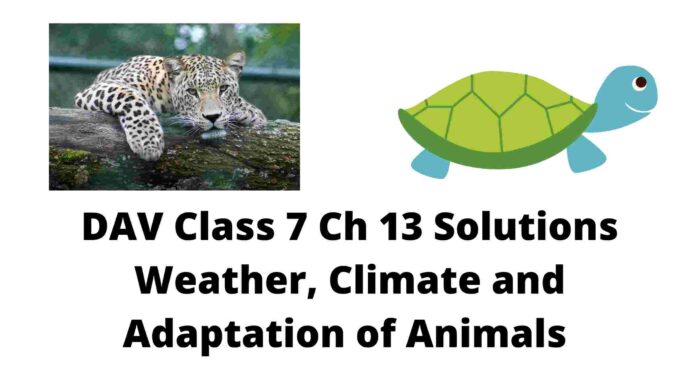
Weather Climate and Adaptation of animals is a chapter in the class 7 science textbook of DAV schools. This chapter talks about the different types of climates in different regions and how it affects the region’s plantation and wildlife. In this article, we have given DAV Class 7 Science Chapter 13 solutions with examples.
DAV Class 7 Science Chapter 13 Solutions
Let us have a look at the solutions to the DAV Class 7 Science book Chapter 13 Weather Climate and Adaptation of animals question answers.St
A. Fill in the blanks.
1. A common measure of humidity, used very often, is known as ___________.
2. ___________, ___________, ___________ and ___________ are different forms of precipitation.
3. ___________ are formed when water vapour, in air, condenses to liquid droplets or ice crystals.
4. The average weather of a place, taken over a period of 20-25 years, will specify its ___________.
5. Rajasthan falls in the ___________ climatic zone.
6. Penguins are different from other birds as they do not have ___________
Answer:
(1) Relative humidity
(2) Rain, drizzle, snowfall, hail
(3) Clouds
(4) Climate
(5) Arid
(6) Hollow bones
B. Match the following:

Ans.
- Humidity: Water Vapour
- Sub tropical: Hot and Wet Summer
- Tropical Rain Forest: Equator
- Red Eyed frog: sucker pads
- Monkey: Prehensile Tail
C. Tick the correct option.
Check questions from the book.
(1) mountain
(2) polar regions
(3) hot and humid
(4) lion-tailed macaque
(5) tassel at the end of the tail
Also Check: DAV Class 7 Monkey Trouble Question Answers
D. Answer the following questions in brief.
1. List the main elements that determine the weather of a place.
Ans 1. The following elements will help in determining the weather of a place:
Rainfall, Wind, Temperature, humiditiy level of the area and the atmospheric pressure value.
2. When are the maximum and minimum temperatures likely to occur during the day?
In a day the maximum temperature reaches in the mid afternoon. The minimum temperature is reached in the morning time.
3. How can forecast, about a ‘clear sky, or an ‘approaching storm’ be made by measuring the atmospheric pressure of a given region?
The atmospheric can help to predict the clear sky or an upcoming storm. If the atmospheric is low then it may indicate that a storm is about to occur. If the atmospheric pressure shows normal values then it means the sky will remain clear on that day.
Also Check: DAV Class Science Acids Bases and Salts Solutions
4. Name the major climatic zones of India. Also mention the names of two states each, that fall in these zones.
Ans. The major climatic zones of India are temperate zone ( Punjab, Jammu and Kashmir), Alpine zone ( Jammu Kashmir and Himachal Pradesh), subtropical zone( UP and Madhya Pradesh), Arid Zone ( Rajasthan, Gujarat) and Tropical ( West Bengal and Maharashtra)
5. Mention two adaptive features of a penguin that help it in swimming.
Answer: The wing and breast muscles are well developed and paddle-like flippers help a penguin to swim in water easily.
6. State the function of sucker pads on the feet of the red-eyed frogs.
Answer: The Sucker pads present on the feet of red-eyed frogs help them to climb trees.
E. Answer the following questions.
1. Differentiate between:
(a) Weather and climate
Answer: The weather of an area keeps on changing whereas the climate is a long term phenomenon. Climate is the weather condition of an area-averaged for longer time periods. It is measured through a period of 25-30 years.
(b) Climate in polar regions and in tropical rain forests.
Answer: The climate in polar regions is cold and associated with cold winds whereas the climate in the tropical rainforest is moderately hot. The area experiences heavy rainfall.
2. What is adaptation? Give one example of each of behavioural and structural adaptations.
Adaptation is the ability of an animal to adjust itself in the surrounding environment. Birds always travel in pairs. This is an example of behavioural adaptations. Camels have padded feet so that they can easily move in deserts. This is an example of structural adaptation.
Also Check: DAV Class Science Book Chapter 12 Solutions
3. Mention any four adaptations that have helped the polar bear to survive in the Polar Region.
Four adaptations of the polar bear are as follows:
(1) Thick coat of fur present on their body.
(2) White fur on the body
(3) A layer of fat under the skin
(4) Strong built body
4. Give reasons.
(a) Big cats have sharp teeth.
Answer: The sharped edged teeth help them in tearing their prey easily.
(b) Some monkeys have long prehensile tails.
Answer: Monkeys climb the tree and keep jumping here and there. The tail helps them to hang from a tree.
(c) Penguins do not have air spaces in their bones.
Answer: This type of structure of penguin help them to swim in the water.
5. ‘The tropical rainforest has a large population of animals.’ Explain why it is so?
The forest has an abundant amount of resources for the animals. A dense cover of plants and food for animals. That’s why it has a large population of animals.
6. How is the trunk useful to the elephant?
The trunk helps the elephant to drink water, life trees and also provides it with a sense of smell. The elephants can sprinkle water with the help of the trunk.
So, these were DAV Class 7 Science Chapter 13 Solutions. We have given detailed solutions to the question answers of Chapter Weather Climate and Adaptation of Animals. Stay tuned to Careeradvice4u for more such DAV Class 7 Solutions for Science and English.

Leave a Reply